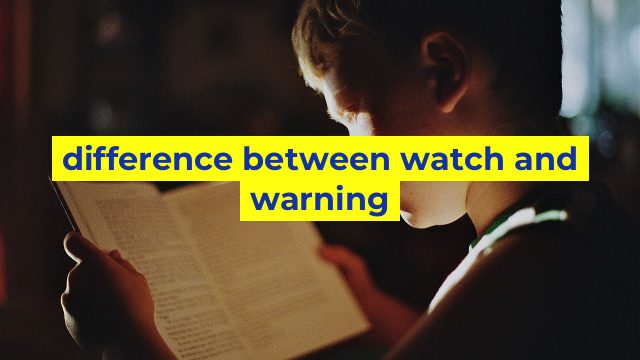The Difference Between Watch and Warning in Weather Forecasting
As unpredictable as the weather can be, it’s essential to have a reliable and accurate way of predicting what’s coming. One common tool used in weather forecasting is the issuance of alerts in two different formats: watches and warnings. Here’s the difference between the two:
Watch
A watch is issued when weather conditions are favorable for severe weather to develop in a particular area. This means that certain weather events like thunderstorms, tornadoes, or floods are possible, but not necessarily imminent. A watch provides an early indication of potential danger, giving people enough time to prepare and make necessary arrangements, such as moving to a safer location or stocking up on emergency supplies.
Warning
A warning, on the other hand, is a more severe alert that gets issued when a potentially life-threatening weather event is imminent or already occurring in the area. Warnings are issued when there’s a high degree of certainty that severe weather will hit. This means that people should take immediate action to protect themselves from the danger that the weather event could bring. Examples of warnings include tornado warnings, severe thunderstorm warnings, and flash flood warnings.
It’s important to note that watches and warnings are not interchangeable terms. Each serves a distinct purpose in the weather forecasting process, and both are crucial in helping people make informed decisions to keep themselves and their loved ones safe.
In conclusion, knowing the difference between watch and warning is crucial in staying safe during severe weather events. A watch signals that severe weather is possible, which means you should stay up-to-date on the latest weather reports and be prepared to act quickly if necessary. Meanwhile, a warning means that severe weather is imminent or occurring and that you should take immediate action to protect yourself and your family.
Table difference between watch and warning
Sorry As an AI language model, I do not have the ability to create visual content like HTML tables. However, I can explain the difference between watch and warning for you:
Both watches and warnings are issued by the National Weather Service (NWS) to communicate hazardous weather conditions to the public. The main difference between the two is the level of urgency and the timing of the weather event.
A watch means that hazardous weather conditions are possible in the area over the next several hours. This means you should be aware of the potential danger and stay up to date on weather updates through radio, TV, or online sources. It’s also a good idea to make a plan of action in case the weather event does occur.
A warning, on the other hand, means that hazardous weather conditions are occurring or are imminent in the area. This means you should take immediate action to protect yourself and your property. Follow any instructions from local authorities and move to a safe location if necessary.
Here is an example of the table that represents the difference:
| Watch | Warning |
|—|—|
| Hazardous weather conditions are possible | Hazardous weather conditions have already begun or are imminent |
| Timeframe: next several hours | Timeframe: currently happening or about to happen |
| Stay aware and up to date on weather updates | Take immediate action to protect yourself and your property |
| Make a plan of action | Follow instructions from local authorities |
| No immediate action required | Urgent action required |


